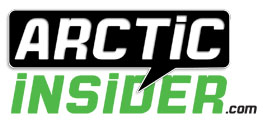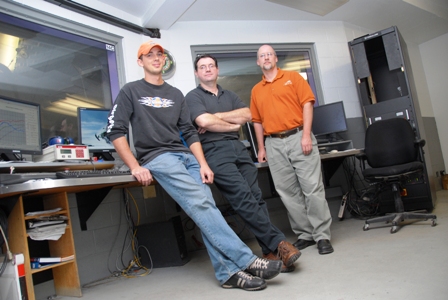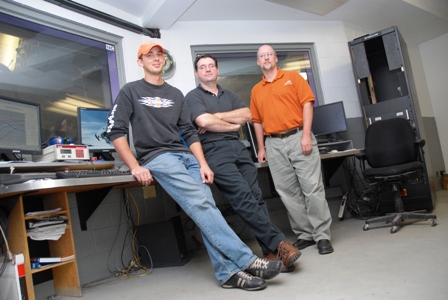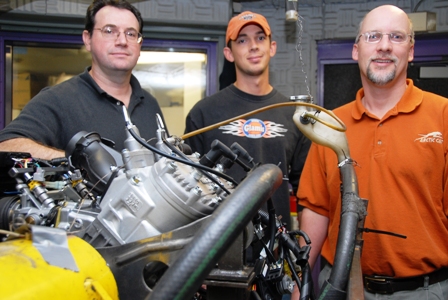This week’s interview is with Glen Martin (middle), Emissions Manager at Arctic Cat. Martin has held this position for almost two years, prior to which he worked on engine emissions for companies like Indmar, Big Dog motorcycles and MerCruiser.
We asked Glen a few emissions-related questions, and he was kind enough to answer.
ArcticInsider: What is the next phase in snowmobile emissions requirements per the Environmental Protection Agency (EPA), and how does it compare to the current phase?
Glen Martin: We’re currently in Phase II, and in we’ll move into Phase III for the 2012 snowmobile season. If a person looks at it straightforward the difference is that maximum carbon monoxide (CO) emissions drop from 275 grams (per kilo Watt-hour) to 200 grams. There is a nice calculation that allows the CO to increase to a maximum of 275 as the HC decreases from 75. If you work with this everyday it is easy, and if you don’t, it is like a second language. Phase III is a huge change and we have to push technology to another level.
AI: What does this mean with regards to the current crop of engines we have available as consumers?
GM: Without getting too technical and not divulging our future product plan, it means the 2-stroke engines that we currently sell must get cleaner. That means using our existing technology in new and better ways, and/or incorporating new technology.
Our Z1 and Z1 Turbo 4-stroke engines currently meet the 2012 Phase III requirement, and in fact earn emissions credits.
It is important to note the Arctic Cat Emissions group’s mission statement: To deliver the highest-efficiency, hp-improving emissions system that our customer doesn’t think about.
What we mean by “doesn’t think about,” is that our emissions systems must work in such a way that they have no negative impact on the customer experience. We will always strive to achieve our emissions goals without sacrificing performance.
AI: Are there other new EPA mandated rules that will come into play in the future, like the gas tank permeability rule?
GM: The EPA typically revisits the rules for an industry every five years. If that remains their timeframe, then 2016 would be the earliest we’d see a new set of retail requirements. However, considering the improvements that have been made and the current economic conditions we are hopeful that there will be a period of stability in regards to emissions levels.
AI: Even in 2012, snowmobile emissions will remain fleet-average, correct?
GM: Correct. That makes it possible for some engines to be higher than the fleet-average emissions levels provided that they are offset by a sufficient number of snowmobiles that emit below the standards.
Like it did with the CAFE (Corporate Average Fuel Economy) standards for automobiles and recreational marine products, the EPA adopted ABT (Averaging, Banking and Trading) provisions when it wrote the rules for the snowmobile industry.
AI: What does the 2012 Phase III requirement mean for fan-cooled 2-strokes?
GM: Sorry, but answering that question would essentially be commenting on future products, which we can’t do.
AI: No problem. I wasn’t trying to get you divulge what engines we’ll see in 2012 and beyond, only trying to learn if 2-stroke fan-cooled engines could be part of the mix. Because I personally see that type of engine as an ideal value-priced mill.
GM: I understand, and I appreciate fan-cooled 2-strokes for the same reason.
AI: Again, not trying to peer into future products but, in your opinion, what does the future hold for 4-stroke vs. 2-stroke engines?
GM: Other industries might give us a glimpse into the future, in particular the marine industry because engines in that application are used in high-load, high-speed conditions. There, both 2- and 4-stroke engines are still viable.
In the European auto industry, which is another application that sees high speeds and loads compared to here in the U.S., they are achieving emissions requirements through the use of catalysts.
One other point I’d make is this: Snowmobilers shouldn’t be scared. I have faith in technology and ingenuity to solve the challenges and hurdles of engine emissions, and to do so in a way that adheres to our mission statement.
AI: Thanks for taking the time to talk, Glen.
GM: Thank you!






This short article seems to speak volumes, thanks for posting it. At times when I read a discussion regarding snowmobile emisions it often is a bunch of posts and comments from people with the sky-is-falling mentality predicting “we’re going to lose this”, “we’re going to lose that”, “so-and-so manufacturer is going to fall on their face when the next emission standards need to be met”…etc. According to your interview with Glen Martin, he and his team are well prepared for the arrival of the next set of EPA requirements. Nice!
I have been working with Glen ove rthe last 4 years on exactly the same problems in other Industry sectors. We have been very successfull in meeting emissions targets and feel confident in our future. I know Glen well enough to say that he knows what he is talking about and will live up to his statements. Nice article to summarize the coming challeneges.
I think we are going to end up with a bunch of new technology out of cat this decade to try and meet these requirements..by the end of the decade the industry is going to see a clear winner on who did the best job of dealing with this situation that our not so wonderful government has put us into.. do the environmetal wacko’s ever take a day off?lol
go cat go… doo is ahead and I don’t like that. I want cat to be leading this parade. You would think having suzuki as a partner they would be?
I am trying to reach Glen Martin. Glen and I worked together at Big Dog Motorcycles. If you give Glen my contact information, I am sure he will send me his contact information. Thank you.